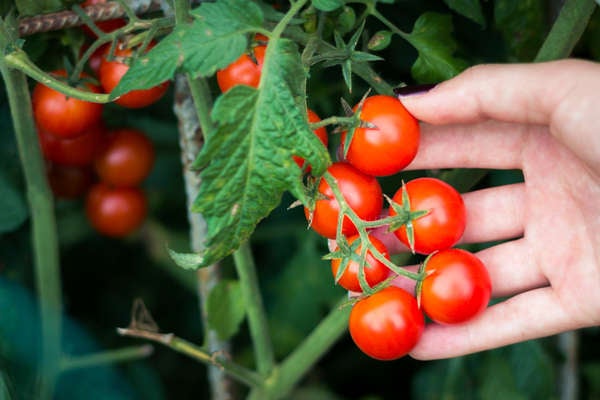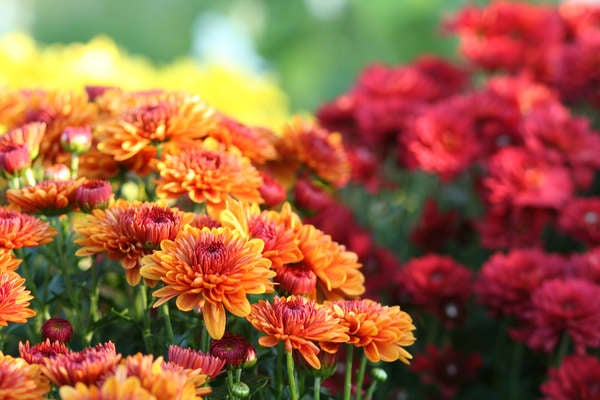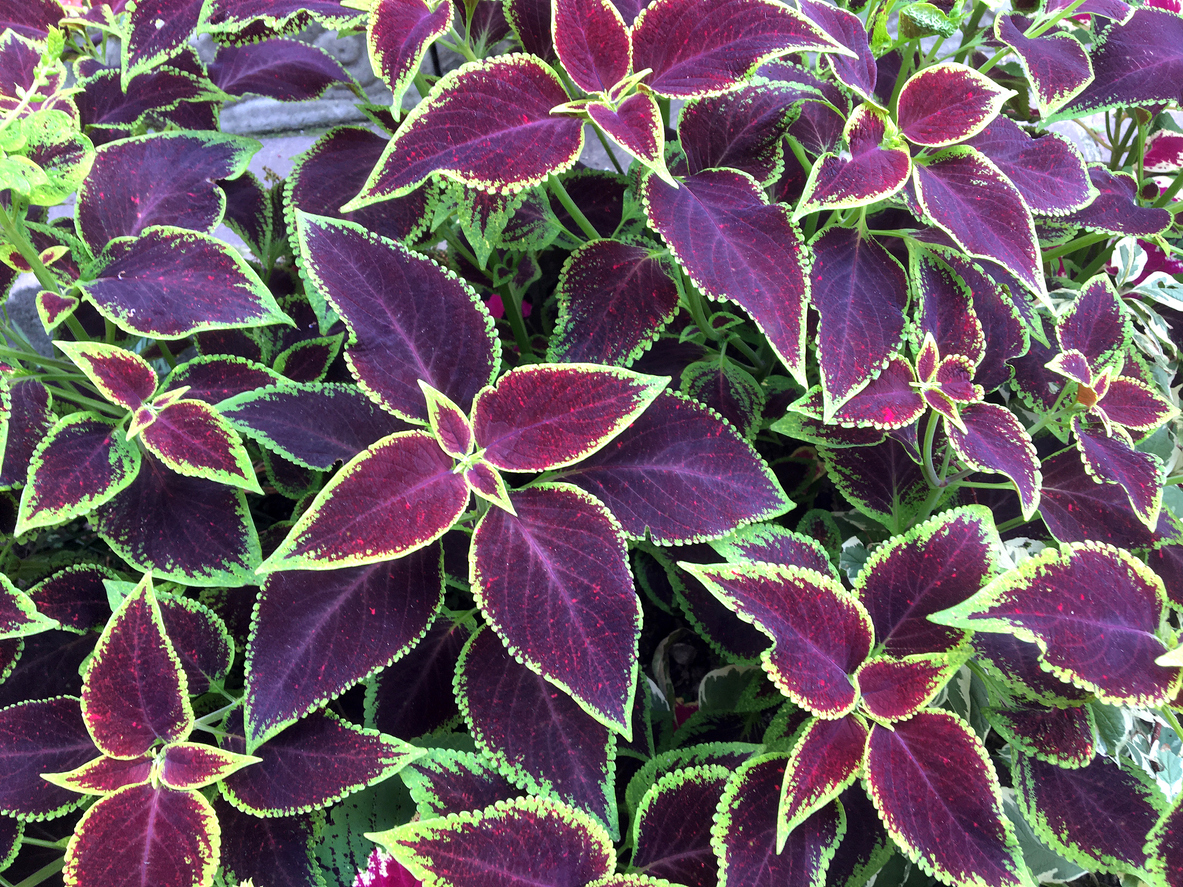We may earn revenue from the products available on this page and participate in affiliate programs. Learn More ›
As warm weather rolls around, there’s nothing quite like lounging in the fresh air surrounded by luscious greenery. With the right plants, it’s easy to turn your patio into a private, colorful, fragrant space that you’ll never want to leave.
Assessing your outdoor space first will help you choose the best patio plants for your situation. Knowing how many hours of direct and indirect sunlight the space gets, for example, will steer you to the appropriate “full sun” or “part shade” aisle at the garden center. Other factors that will affect plant choice include your local climate, the amount of water a plant needs, and the size of the containers in which you’ll be potting the plants.
1. Tuberous Begonias (Begonia x tuberhybrida)

Tuberous begonias are an excellent choice for a patio plant, and their bright pink, red, and white petals will add a pop of color to your space. The tuberous variety of begonias is the easiest to care for and features the biggest blooms, but it needs a big pot to grow. (Be on the lookout for Nonstop and Roseform Red tubers, both of which are stunning.) Although tuberous begonias can thrive in full shade, they bloom best with at least 4 to 6 hours of indirect sunlight. Plant them in the spring well after the danger of frost has passed, in well-drained soil to prevent root rot.
2. Million Bells (Calibrachoa)

Calibrachoa, or million bells, is an annual bloom that comes in a wide assortment of colors and patterns. Thanks to their long blooming season, which starts in the spring and continues into the fall, they’re a popular container plant. Recognized by their hanging stems, million bells can be planted in a variety of patio-ready containers, like hanging baskets, pots and window boxes. Million bells need moist yet well-drained soil, and though they prefer full sun they grow almost as well in part shade.
RELATED: How to Grow Calibrachoa
3. Lavender (Lavandula)

Turn an outdoor space into a calm, spa-like retreat by integrating a few oversized pots of lavender. Recognized by its rich purple hue, lavender’s aroma is also known to reduce anxiety. Patio gardeners can choose from a few varieties of lavender, but all need a spacious container with a half-inch draining hole and plenty of room to grow. For optimum fragrance and growth, lavender requires at least 6 hours of full sun.
4. Sweet Alyssum (Lobularia maritime)

Sweet alyssum’s tiny bloom clusters and delightful fragrance make it a terrific pick for patio gardens. There are so many good reasons to grow it: Is a hardy, adaptable plant with a long blooming season, and spreads beautifully when planted in beds. In hanging pots or baskets, sweet alyssum often spills over the sides. Other points in its favor are that it can be potted in various containers such as a window box, hanging basket, or ornamental planter, and does well sharing a container with other plants. For best results, feed sweet alyssum with a diluted, water-soluble fertilizer every other week and make sure it receives at least 6 hours of full sun per day.
RELATED: 12 Best Flowers for Starting from Seed
5. Cherry Tomatoes (Solanum lycopersicum var. cerasiforme)

Cherry tomatoes are excellent patio plants: They add color to your outdoor space, and are delicious to boot. Though there are numerous cherry tomato varieties from which to choose, what they have in common is that they grow like crazy (particularly indeterminate cherry tomatoes), and thus require staking and appropriately roomy patio containers.
Tomatoes require at least 8 hours of full sun, although a little less will still yield a healthy, though perhaps not as prolific, harvest. Cherry tomatoes also require soil that is well watered, well drained, and enriched with organic nutrients.
6. Strawberries (Fragaria × ananassa)

Strawberries are compact plants that grow well in containers and, like cherry tomatoes, are a lot of fun to grow in containers on decks or patios. The things to remember about strawberry plants are that they need to be planted by early summer, and they thrive in full sun. Water them deeply as soon as the soil surface appears dry, and make sure the soil drains well and does not get soggy. To avoid fungal diseases, try to keep the plants’ leaves dry. Strawberries take just 90 or so days to harvest, so if they’re in pots by Memorial Day you should be plucking berries out of your patio pots before Labor Day.
RELATED: The Best Soil for Strawberries
7. Roses (Rosa)

Roses are go-to container plants, but don’t think they’ll thrive in yogurt cup-sized containers. They need ample space for their long-reaching roots, so be sure to plant them in pots that have a wide diameter and at least a 2- to 2 1/2-foot depth. They’re heavy feeders—apply rose fertilizer frequently, according to package instructions—and should be situated in a patio spot that receives at least 6 hours of full sun. Don’t be tempted to add more plants to roses’ spacious pots, though. They are not good companion plants.
8. Marigolds (Tagetes)

Marigolds produce spectacular warm-toned flowers in orange, yellow, and red hues. Just about every type of marigold can be grown in a container, but they need plenty of air circulation and growing room to thrive. Aim for at least a 6-inch diameter around a single marigold plant. Marigolds need at least 6 hours of full sun per day, and should be watered when the top layer of soil is dry.
RELATED: 3 Reasons You Should Always Plant Marigolds in Your Garden
9. Chinese Hibiscus (Hibiscus rosa sinensis)

The Chinese hibiscus is a tropical flowering shrub with large, vibrant flowers that stay open from spring well into the fall. When grown in the ground, it can grow tall and bushy. When potted, however, this species produces earlier and longer-lasting blooms with less shrubbery.
Hibiscus should be brought indoors in cold weather—it can die when temperatures hit 25 degrees Fahrenheit. In warm weather, they thrive on a patio or deck if they have 6 to 8 hours of full sun, constant watering, and are planted in well-draining potting soil.
10. Cannas (Canna)

Also known as canna lilies, these tropical bulbs have bright, patterned petals and leaves. Cannas prefer warmer temperatures and should not be planted until the soil reaches at least 60 degrees Fahrenheit. They require just 4 hours of direct morning or afternoon sunlight, so they’re good plants for patios that do not get full sun. Gardeners in Zone 1 through 6 will need to dig canna bulbs up in the fall before the first frost to preserve cannas for the following growing season.
RELATED: Late Bloomers: 25 Summer Flowers to Keep Color in Your Garden
11. Fan Flowers (Scaevola aemula)

Fan flowers are a unique patio plant with delicate, fan-shaped petals. Once these hardy flowers are established, they are drought and heat tolerant and attract butterflies and bees. Often grown in containers, hanging baskets, and window boxes to show off their magnificent trailing habit, fan flowers also add a colorful pop to a patio border. Requires full sun.
12. Hybrid Fuschia (Fuchsia x hybrida)

Hybrid fuschias are often planted in hanging baskets to show off their trailing, tear-dropped pink and purple blooms. They are good companion plants and require little sunlight to flourish, making them a terrific choice for shaded patios. Fuschias prefer moderate temperatures and humidity levels, and should be brought inside when temperatures dip below 55 degrees Fahrenheit. Hybrid fuschia are particularly ideal for containers because of their compact size, and because they need to be kept out of the cold.
RELATED: 30 Gorgeous Plants That Attract Hummingbirds to Your Garden
13. Chrysanthemums (Chrysanthemum × morifolium)

Chrysanthemums, also known as garden mums, are autumn plants that do not bloom until the late summer months. They are a sun-loving daisy variety that require at least 4 hours of full sun to thrive. They’re thirsty plants too, and will need to be watered two to three times per week once the blooms open. Mums can be toxic to cats and dogs, so be sure to keep them away from pets.
14. Lantana (Lantana camara)

With colorful flowers and a light fragrance that attracts bees and butterflies, lantana is a lovely patio plant. It can grow up to 6 feet tall, so a few strategic pots on your patio might provide some privacy, or block an unsavory view. (Be sure to pot these tall plants in sturdy containers that won’t tip over easily.) Gardeners who aren’t looking for plants with this much height should seek out dwarf varieties of lantana, which are suitable for smaller containers. Make sure your lantana gets direct bright sunlight, and keep the soil well watered but not soggy. This plant thrives in warmer climates; gardeners who live in colder climes will need to overwinter lantana indoors.
RELATED: 20 Plants That Thrive Even When Temperatures Rise
15. Cosmos (Cosmos bipinnatus)

Cosmos is a cheery flower that needs full sun and moderate water to flourish, and comes in a spectrum of colors ranging from white to pink and bright orange. Cosmos attract pollinators, so patio gardeners should not be surprised to find more butterflies and birds around when this flower is in bloom. For a charming display that captures the spirit of a meadow, consider planting cosmos with wildflowers.
16. Boxwood (Buxus)

Gardeners who seek low-maintenance patio plants that provide foliage rather than flowers should consider boxwood, a shapely shrub that transforms a patio space from bland to elegant. Boxwoods don’t like having soggy roots and should therefore be planted in a large pot with well-draining soil (adding a layer of mulch is a good idea too). After the plant is established, it only requires a thorough watering about once a week, and even less frequently in the winter. Boxwood does well in cold climates, but it’s a good idea to cover them for the winter because their branches can break under the weight of heavy snow.
RELATED: 25 Ways to Upgrade Your Outdoor Living Space for Almost Nothing
17. Geraniums (Pelargonium)

Geraniums are iconic garden flowers best known for their lush green leaves and brilliant petals. Although they grow best in warmer climates (zones 8 to 11), geraniums can be grown in cooler climes but will need to be overwintered indoors when temperatures dip. These perennials require direct sunlight, moderate moisture, and periodic deadheading to promote continuous, healthy blooms.
18. Heliotrope (Heliotropium)

Heliotropes are perennials that are known for their pleasant, almost vanilla-like scent—what a great sensory addition to an outdoor lounging spot! Their white- and purple-toned flowers begin to open in the summer and grow in unique, asymmetrical clusters. Heliotropes grow well in containers and require at least 6 hours of full sun. As beautiful as they are, however, pet owners should beware that the flowers are toxic if ingested.
RELATED: 11 Fragrant Plants for Creating the Ultimate Aromatherapy Garden
19. Gardenia (Gardenia jasminoides)

Gardenias’ bold white flowers and intoxicating scent make this beloved, albeit high-maintenance, plant a favorite among gardeners. Gardenias are temperamental plants that can die easily if they do not receive careful and exacting care. It grows well in partial shade or full sun, but requires acidic soil and warmer temperatures to flourish. Though gardenia typically blooms year round in zones 8 through 11, gardeners in colder zones may not see blooms if the temperature falls below 60 degrees Fahrenheit.
20. Feather Reed (Calamagrostis x acutiflora)

Those who seek a unique plant for their patios—and one that provides some privacy—should consider decorating their space with potted, low-maintenance ornamental grasses such as feather reed. This tall grass has a green stalk and arching plumes that sway in the breeze, and can reach heights of up to 5 feet. Feather reed requires medium to wet soil and can survive winters in zones 5 to 9.
RELATED: The 22 Best Ornamental Grasses for Adding Drama to Your Property
21. Paperplant (Fatsia japonica)

Paperplant’s 12-inch glossy leaves with deep, serrated lobes are truly showstoppers, offering a tropical vibe to your decor. You’ll need plenty of space for this Japanese native: It can grow to 10 feet tall and wide, making it an excellent screen if you’re looking to add privacy to your patio. This shade-loving plant is also trimmable, so you can prune it as needed. During the spring and summer growing season, keep the soil moist at all times, and give it a little fertilizer weekly. In winter, water when the top inch of soil has dried out. Paperplant is hardy to zone 8.
22. Coleus (Coleus scutellarioides)

Coleus’ bright color comes not from flowers but from its beautifully hued leaves, which are often toned in more than one color, including red, pink, purple, green, and yellow. As many coleus varieties tolerate full shade, it’s a good choice to add color to the inner reaches of your patio. Various cultivars can grow anywhere from 6 to 36 inches tall, and coleus is very easy to grow from seed. It needs consistent watering, so don’t let it dry out. Coleus is winter hardy to zones 10-11.
RELATED: How to Grow Coleus
23. Asparagus Fern (Asparagus densiflorus)

Not a fern at all, asparagus fern is in the asparagus family (or the lily family, depending on the classification system used). There are several types, all of which make wonderful container plants. Some are upright, while others spill nicely over the side of a hanging basket. Their needle-like foliage adds a lovely contrasting texture to other plants you may have on your patio. Give asparagus fern medium light and let it dry out between waterings. Hardy in zones 9 to 11, this spindly plant will need to overwinter indoors in other zones.
24. Caladium (Caladium)

These large- and colorfully leafed beauties would do well in a big container placed in a spot that gets a bit of morning sun, but afternoon shade. Most caladiums grow to 12 to 24 inches tall, but some varieties get as tall as 3 feet. Keep the soil moist but not wet, and fertilize weekly with a balanced fertilizer. They’re winter hardy to zone 9 or 10, so northern gardeners might need to bring them inside to overwinter.
RELATED: 10 Fall Flowers That Are Hardy in Cold Weather
25. Mandevilla (Mandevilla)

If you have patio roof support posts that are begging for adornment, consider mandevilla, a fast-growing climbing vine that rewards growers with trumpet-shaped flowers in any of several hues. Be sure to put your mandevilla in a sunny spot; these climbers need at least 6 hours of sun daily. They’ll do best with a high-phosphorus fertilizer every 2 weeks, and a good watering when the soil is dry to the touch. Mandevilla is root hardy to zone 8; gardeners in other areas might need to cut the vines to a few inches tall and move the container inside come winter.

